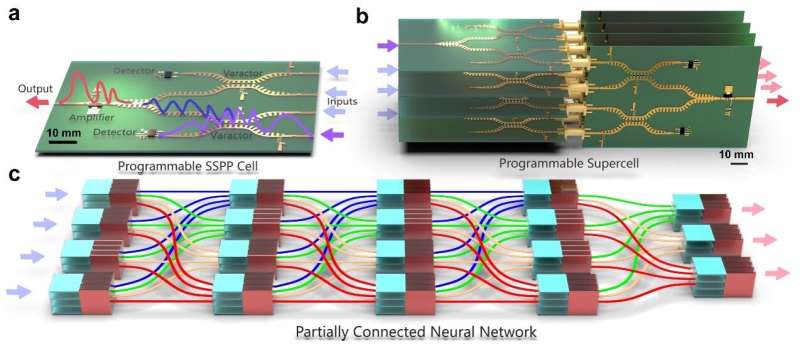Researchers at the Southeast University in China have developed a programmable neural network using a spoof surface plasmon polariton, an electromagnetic wave propagating along planar interfaces.

Artificial Intelligence (AI) tools based on artificial neural networks (ANNs) are being adopted in various areas for faster and more efficient problem-solving. Engineers are exploring diffractive optical devices as an alternative platform for running these algorithms.
A research team led by Prof. Tie Jun Cui at Southeast University in China have created a programmable neural network utilizing a spoof surface plasmon polariton (SSPP), a surface electromagnetic wave moving along planar interfaces. The researchers aimed to enhance neural network performance and applicability to various problems. The proposed surface plasmonic neural network (SPNN) architecture is programmable with different weight configurations, thus able to generalize across tasks.
The team have created a neural network with programmable weights and activation functions capable of high processing speeds close to the speed of light. The SPNN was built layer by layer using programmable SSPP supercells, each with four inputs and four outputs. These supercells comprise eight programmable SSPP cells arranged in a three-dimensional composite structure that facilitates full connection. Programmable supercells comprising SSPP power divider and coupler manipulate electromagnetic waves to realize plasmonic neural networks. The researchers explained that varactor voltages on couplers modify the SPNN’s weight parameters, and its activation function is customizable by detectors detecting input intensity and feeding the threshold back to an amplifier. The SPNN can perform image classification and wireless communication tasks for image decoding and recovery.
SPNN has programmable weights and activation functions, making it versatile. Unlike previous approaches that used phase change materials, it offers a wider dynamic range. Diffractive deep neural networks’ flexibility in processing electromagnetic waves is limited by their lack of nonlinear activation functions, making it difficult to handle complex problems like XOR logic operations. The programmable SPNN proposed by the team using digital surface plasmonic devices could introduce novel concepts to the field. With a simple architecture, low cost, and high efficiency, programmable SSPP devices can manipulate electromagnetic waves, making them a promising platform for building programmable neural networks. A closed-loop feedback system between detection ports and amplifier bias circuits can also enable programmable activation functions.
The SPNN developed by the team may enable large-scale detection and processing of microwaves, potentially opening up new possibilities for 5G and 6G wireless communications. Unlike previous ANN-based solutions, the SPNN can directly modulate electromagnetic waves at near-light speeds.
Reference : Xinxin Gao et al, Programmable surface plasmonic neural networks for microwave detection and processing, Nature Electronics (2023). DOI: 10.1038/s41928-023-00951-x






